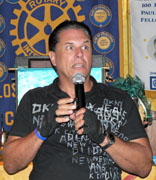Disabled Student Services at CSULB, by David Sanfilippo

David Sanfilippo, sitting in a wheelchair, was introduced to us by his longtime friend and colleague, Sandy Farrell (who had worked with him years ago in student counseling). His career in disabled student services started with an opportunity to work in a high school program for people with disabilities. He was feeding a man with cerebral palsy, who began drooling on him. Then he began trying to teach the man how to tie his own shoes. That inspiring experience led to a job at a summer camp with children and adults with disabilities, which he continued for a few summers, and then got a job at a community college working with people with disability.
Since 1978, he has been the Director of Disabled Student Services at California State University in Long Beach, one of the first University programs of its kind. He develops and coordinates services for disabled students and supervises professional counselors, staff, interns, student assistants and volunteers. He has been a consultant for the federal disability law (ADA) on public accommodations, and has been active in state, city and University activities to help the disabled (or “special needs”, a more polite term). Categories of disability include physical (neuromuscular and orthopedic), physiologic, mental, and psychological. They can be congenital, developmental or traumatic, including the increasing numbers of injured war veterans.
David is writing a book, “Where I Sit”, discussing the inspiration he feels from students and others overcoming obstacles. He discussed the relativity of “accommodations”: lighting could be considered an accommodation to sighted people, and high doorways could be an accommodation for walking people. Sports activities can help motivate people to overcome their handicaps. He discussed anecdotes of sports successes, including a champion woman swimmer, a track star, and a football star injured by a bullet followed by a 70-pound weight loss in the hospital, who returned to play football and played for the San Diego Chargers. One man who was born with no arms or legs (phocomelia, from the thalidomide drug during pregnancy), was given up for adoption but grew up to become an advisor to the US Dept of Transportation on disabilities. Another student had a severe neck spinal cord injury, but went on to a law degree and a job in the Orange County DA Office.
Over 35 years, he has had 6000 students in his program. Your tax dollars are helping these disabled young people to grow into productive careers and more independent lives. He noted that student loans in the US have gone up to a total of $1 trillion now, a burden that is financially handicapping more students from completing college to enable them to contribute to the US economy with productive careers. He is concerned that decreasing support for public education will endanger his program as well as the future success of other students. (At this point, David got out of his wheelchair and stood up normally, to show the perspective of our expectations of those who appear to be handicapped.)